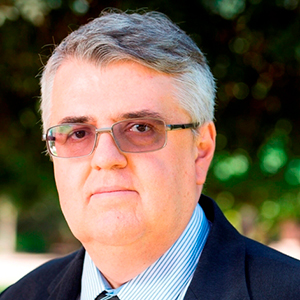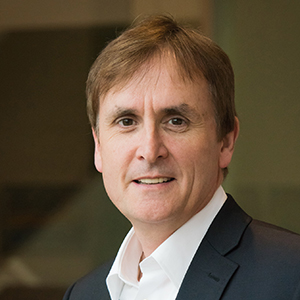As the Robinson family headed off into the unknown reaches of outer space in a quest to get to Alpha Centauri, Robot was there to serve.
Robot was loyal, protective, and informative. He even had a sense of humour and only once or twice did he go off rails when someone interfered with his programming – turning him from good robot to bad robot, with just a tickle to his operating system.
But is it in that 'tickle' that all our fears lay? Robots are fine as long as they don’t turn on us and they don’t replace us.
 Cultural studies expert and Head of UniSA’s School of Communications, International Studies and Languages, Professor Jason Bainbridge, says robots, automatons and cyborgs all sit in our cultural landscape as 'others' – right alongside vampires, zombies, monsters, aliens and in the modern context, even refugees.
Cultural studies expert and Head of UniSA’s School of Communications, International Studies and Languages, Professor Jason Bainbridge, says robots, automatons and cyborgs all sit in our cultural landscape as 'others' – right alongside vampires, zombies, monsters, aliens and in the modern context, even refugees.
“At the heart of all our fear of robots is that they will replace us, either by turning rogue and wiping us out, or simply by being better at everything – making us redundant in our own world,” Prof Bainbridge says.
Interestingly, the word robot, drawn from an old Church Slavonic word, robota – meaning servitude, forced labour, or drudgery – was coined by Czech writer Karel Capek in his 1920s play R.U.R. (Rossum’s Universal Robots).
Loosely, the play’s plot shows humanlike robots invented to serve mankind, finally overthrow their masters and destroy the human race. Perhaps a product of the prevailing political ructions in Europe and a backlash against growing mechanisation, with Capek’s play, the notion that we should really fear our own technological creations, had well and truly taken hold early in the 20th century and has powered on in popular culture ever since.
Prof Bainbridge says there is really no utopian construction of robot-human coexistence in popular culture.
“There are very few occasions where robots are entirely benign,” he says.
“We have sidekicks like K9 in Dr Who, C-3P0 and R2D2 in the Star Wars films and a few other animated characters such as Gigantor in Japan – but generally we are up against Daleks, Blade Runner’s replicants, HAL 9000 or the chillingly lifelike Synths with ambiguous motivations, from Humans,” he says.
“Those deep fears and suspicions, seeded in the landscape of film and literature, will influence how we adapt to change – they are bound to,” he says.
“However, while the spectre of robots that are just like humans looms large in our psyche, technologically that seems to be a fair way off. Even though there are some pretty lifelike examples of androids, they don’t function seamlessly.
“Probably a more pertinent concern is that we are blurring the lines between ‘man and machine’.
“Well beyond the special bionic additions we saw in The Six Million Dollar Man, there is a genuine fear among neuroscientists and others, that pervasive technologies, such as smartphones, have started to shape humans.
"There is deep concern that the technology will drive our evolution, influencing or even confusing what it is to be human.
He says films like Her, where the leading man, lonely and going through divorce, falls in love with the talking and learning intelligence that is his computer operating system, give flight to that notion.
"This film more than many others makes us question what makes us human – is it our mind, our body, our capacity to feel and be sensitive to others – or do we need the whole package?”
 But for UniSA’s Dr Romeo Marian, sci-fi notions of robots, merely muddy the waters.
But for UniSA’s Dr Romeo Marian, sci-fi notions of robots, merely muddy the waters.
A 30-year veteran of the robotics industry, he says the fears and questions about robots and the impact they may have on people, work and everyday life, are the same now as they were in the past.
“The way robotics is imagined in the future – the whole human-like android – is quite different to what many researchers working in the field are concerned with,” he says.
“Original research into mechatronics aspired to put machines next to people to improve productivity.
“But in the future we will see machines operate alone. Still, their role will be to complement humans – to fulfil repetitive functions and to manage complex systems – they will not, however, be like humans.
“Robots have a limited amount of memory and a finite storage capacity. Life is infinitely complex.
“Humans are creative – robots are not. Even ideas of creating artificial intelligence are limited by how we define intelligence itself – something evidenced by the failure of everyday IQ tests.
“I am looking forward to a system of driverless cars, for example, because it is a system that could be established to great advantage both in terms of safety and the huge amount of time it would free up for me to do more useful things.”
And imagining a future near or far where suddenly everything will be done by robots, Dr Marian says, takes little account of where we already are.
“These things are unfolding,” he says. “We won’t suddenly all have no useful function overnight because robots have ‘taken over’.
“If we just think about all the machines that work for us now, that involve robotics and IT systems, we can see that this is an evolution.
“The evolution of robotics, developments that help and complement humans, has already been happening for 40 or 50 years and what we find is that problems evolve with the machines that can solve them.
“The way I see it, there isn’t much to fear – the complexity of the world will evolve with the technology.”
 Professor of Sociology, Anthony Elliott believes it is the confluence of rapid technological advances – robotics, artificial intelligence, the coming of the internet of things, drones, cloud technology, nanotechnology and biotechnology – that is so challenging to social and economic order.
Professor of Sociology, Anthony Elliott believes it is the confluence of rapid technological advances – robotics, artificial intelligence, the coming of the internet of things, drones, cloud technology, nanotechnology and biotechnology – that is so challenging to social and economic order.
“We have entered a Fourth Industrial Revolution, or what I term ‘technological tsunami’ – one that will change not only social and economic relations, but also our most personal interactions,” Prof Elliott says.
“It is not only about how AI and robotics will affect the provision of labour, but also about how we will adapt to working alongside the highly ‘intelligent’ machines and systems we create.”
Prof Elliott, a Fellow of the Academy of the Social Sciences in Australia, has just been funded by the European Commission through its prestigious Jean Monnet Actions scheme to lead research into the impact of robotics in both the EU and Australia.
In collaboration with colleagues from universities and industry in Germany, Poland and Finland, he will explore EU policy in key areas of technological innovation and employment changes.
“We are at the precipice of the most profoundly disruptive technological shift in history and it will challenge our notions of work and leisure, of community and communication and of human relationships,” he says.
“The policies we develop to manage that transition will be vital.”
In a separate project funded by the Toyota Foundation, Prof Elliott is also working with a multidisciplinary team of researchers at Keio and Rissho Universities in Japan, where robotic technologies are already being applied in the aged care sector.
The project - Assessment of Socially Assistive Robotics in Elderly Care: Toward technologically-integrated aged care and wellbeing in Japan and Australia - is focusing on how robotic technologies are being applied in the sector today and how well they are working.
With all western nations facing a rise in aging populations and not enough workers to deliver aged care, Prof Elliott says socially assistive robotics may provide part of the solution.
“From the monitoring of patients and their medicines through to the physical lifting of patients carried out by robotic systems, AI and robotics raises a range of issues to explore and evaluate.
“On the plus side, the potential for robotics to remove repetitive or high risk tasks from a carer’s day, could free up many hours, giving them time for quality engagement with the people they care for.”
But as Prof Elliott says, there is a wide range of issues to consider.
Will robotic replacement of care workers be implemented simply as a cost saving for the industry without any assessment of perceived quality care? Will robots signal huge job losses in the sector? What are the learning and sociological outcomes for an industry area if basic skills never need to be done by humans?
Will the older people feel unsafe or intimidated by the technology and how should we design it to improve acceptance?
How will human nurses and care workers interact in a workplace where they must trust machines to do duties they used to be responsible for? What procedures are in place to protect against system failure and if it does fail and cause harm, who is responsible?
What are the longer term outcomes for a society where machines provide services that can also be provided by people – will one service be premium and the other budget, and which will be which?
Prof Elliott says the implications of this looming technological revolution are moving us “off the edge of history”.
“We are entering a period of unrestrained experimentation,” he says. When we get to a point of convergence where the technologies are no longer clunky or flawed and we can have virtually seamless integration of robotics and AI in our lives, we need to have considered how they will be accommodated in societies,” he says.
“Science fiction and popular culture may haunt us with doomsday predictions about the impact of AI and robotic technologies, but we should not ignore the potential benefits – improved surgery and healthcare, enhanced learning, improved safety standards in a range of fields and access to services where none may have existed before.”